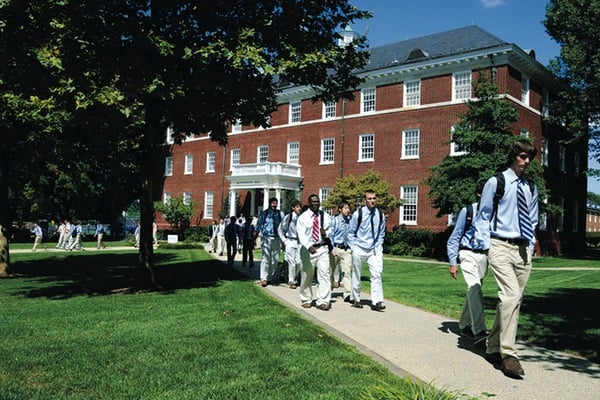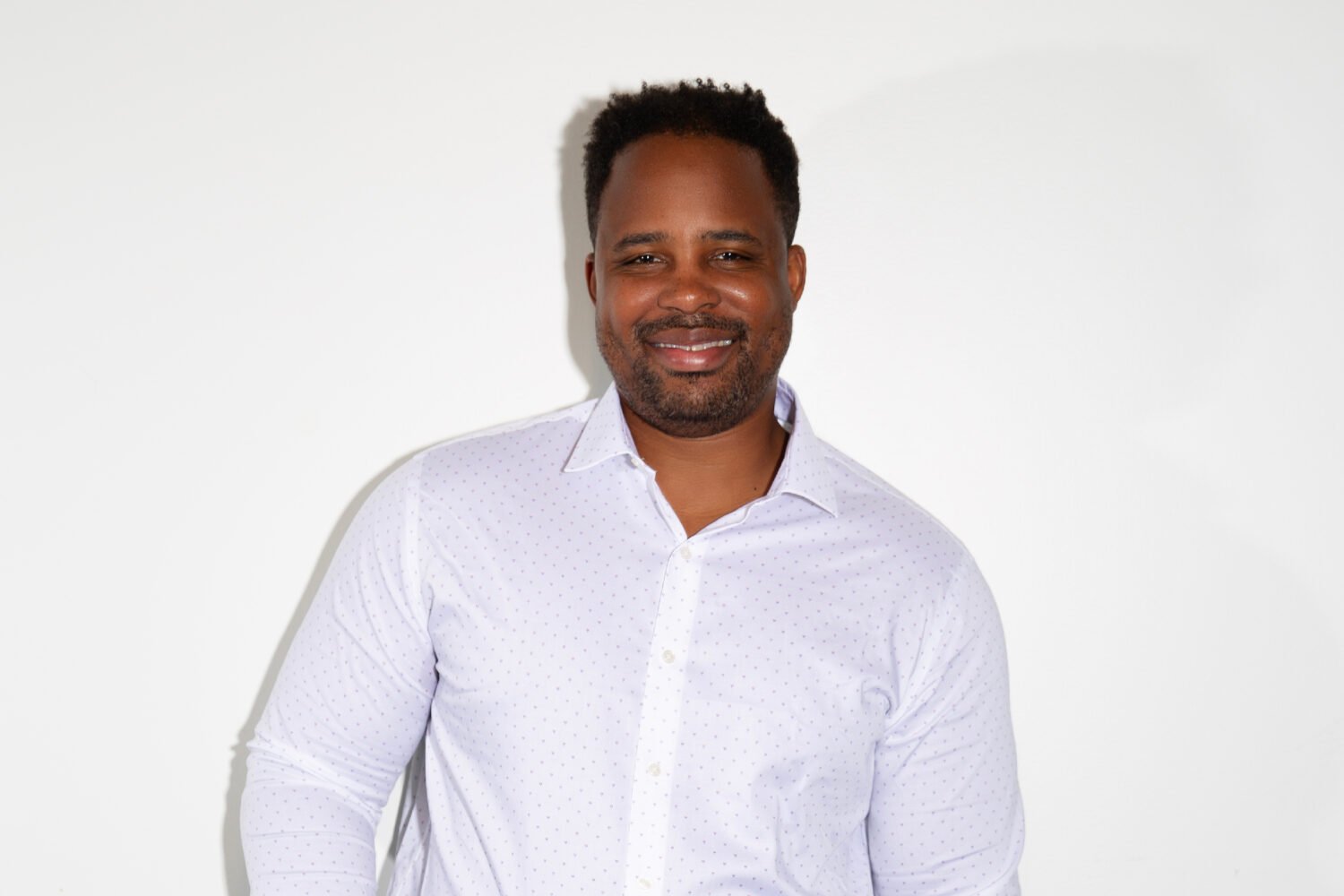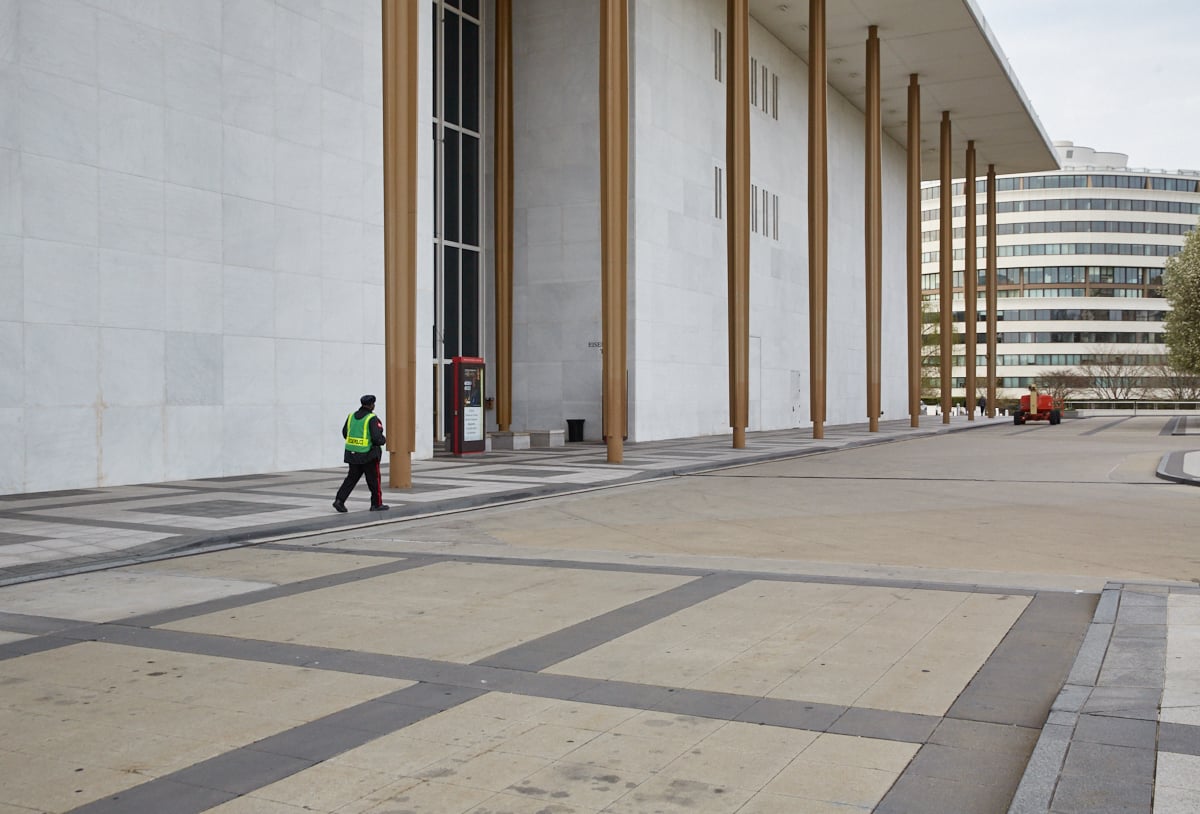Georgetown Prep in North Bethesda gets about four applicants for each day-school slot. Photograph courtesy of Georgetown Preparatory School
A jigsaw puzzle. A balancing act. An intuition.
Schools describe their admissions choices in a lot of ways, but one word seems to sum up the process best: complicated. Figuring out the right school for your child—and getting him or her accepted—can be an exercise in patience.
See Also:
Our Guide to Private High Schools
What To Ask When You’re Checking Out A School
The Pressure at Top Private Schools
Mary (not her real name), a DC mom with sons at two local private schools, knows this all too well. Getting her older son into pre-K required writing 35 mini-essays, touring seven schools, and meeting with one admissions director after another.
“The hardest part is figuring out what’s best for your child,” she says. “And if you have multiple children, one school might not be best for both of them. For me, that was tough.”
Neither Mary nor her husband grew up in the area, so there were no “legacy” ties to consider, no real frame of reference to separate one school from the next. Mary pored over hundreds of school listings, Web sites, and online forums, eventually settling on seven possibilities for her older son.
When admissions season rolled around for him, the first step was the written application. Each school required paragraph-long answers to five or six questions about her son, and Mary felt compelled to adapt her tone for each place. “If you’re applying to a progressive school, you want your response to be more progressive; if you’re applying to a Quaker school, you want to appear more wholesome,” she says. “It was like applying to college.”
Next it was time for the “play date,” an admissions criterion required by most private schools. Mary’s son would spend an hour or so engaging in structured play with a handful of other candidates as teachers evaluated his ability to interact and follow instructions. This was fun for him at first, but by the seventh play date his enthusiasm had faded. “He’d say things like ‘Do I really have to do this again?’ ” Mary says.
There were more steps, including a cognitive assessment and a teacher recommendation from his nursery school. The process took more than six months, but Mary’s son got into most of the schools he applied to and his parents were thrilled to find one they felt was the right fit.
“It’s a lot of work and a lot of time, but what decision could be more important?” says Diane Dunning, director of admissions and financial aid at Alexandria’s St. Stephen’s & St. Agnes School. “We’re fortunate to be in an area with so many wonderful choices, but at the same time it’s completely overwhelming.”
That’s in part because many schools here have become very selective, especially at the high-school level. Georgetown Prep in North Bethesda, for example, receives about 400 applications for just over 100 day-school slots each year. Washington International School in DC gets three to five applicants for each spot. And while schools don’t like to talk about it, many give priority to “legacies” (children or grandchildren of alumni), minorities, star athletes, and the kids of donors and prominent people.
One way to keep the anxiety in check, says Leigh Ann Cahill, founder of the Alexandria-based educational consulting firm Independent School Options, is to focus on what’s best for the child instead of for mom and dad. “We like to ask parents to look at their child, then look at a Maret or a Georgetown Day or a Potomac School and see where they mesh and where they don’t,” she says. After that, the project is more doable: Narrow down your list to schools that seem like a fit for your child, then educate yourself on how to get him or her there.
The Lower Grades
Most lower schools follow the same four-pronged approach that Mary describes: a written application; an observational visit; a cognitive screening; and a recommendation from a teacher, daycare provider, playgroup coordinator, or someone else who has worked with the child. But the process can vary by both school and grade.
Admissions directors say no single component is more important than the others. “We really do value each piece pretty equally,” says Christina Tait, director of admissions and financial aid at the Langley School in McLean.
Cahill, however, says the play date is the make-or-break for pre-K and kindergarten: “The child’s ability to stay grounded is key—the ability to really adapt and transition, to interact with a few other children, and to function as a typically developing kid.”
The Wechsler Preschool and Primary Scale of Intelligence, known as the WPPSI (pronounced “whip-see”), is the SAT of lower-school admissions. The 20-to-60-minute test is administered by an evaluator at an educational-testing center. It evaluates a child’s level of cognitive functioning and is often required for students entering pre-K and kindergarten.
“The WPPSI is actually very, very kind—most students fall in the 90th percentiles,” Cahill says, noting that this can create some interesting “But my kid is a genius!” situations.
Admissions directors say they aren’t that concerned with the score itself. “I’m not looking for rocket scientists—we do have some of those here, but we also have students with very average scores,” says Kathleen Visconti, director of admissions and financial aid at DC’s Washington International School. “What I’m looking for are any discrepancies that fall below the normal level. That can be a red flag.”
Because four- and five-year-olds don’t have academic records and may not be able to describe their intellectual interests and aspirations, the focus shifts to the family. “The parents are the ones who are actually completing the application, so there’s a relationship we build with them,” Tait says. “And really, we are looking for families who support our mission and philosophy.”
So how do admissions directors sort through the stacks of applications for pre-K and kindergarten? “That’s the hardest part of my job,” Visconti says.
All other things being equal—solid play-date visits, normal WPPSI scores, good recommendations—it’s about rounding out the classes to make them as heterogeneous as possible. “It varies from year to year, but we’re looking for diversity—gender, ethnic, socioeconomic, geographic, and a variety of talents,” Tait says.
“If you are a Jewish student who’s applying to an Episcopalian school, your chances went up a little bit,” Cahill says. She advises parents not to “beige out” their kids. “Being a little left or right of center can be a really good thing,” she says.
Three years later, they started all over again with their second child.
Kindergarten is the main entry point for lower school; for middle school, it’s sixth grade. The number of spaces available in the grades in between depends on attrition. “First grade is usually the worst, but after first, space tends to open up a bit more,” Cahill says.
In first grade, schools begin to require academic transcripts, and instead of the WPPSI they use the WISC-IV, a cognitive test geared toward children ages 6 to 16. In sixth grade, the focus shifts from the parents to the applicants—many schools begin to require one-on-one interviews, and the students are asked to write their own statements.
Making decisions about which young children to admit is harder, and more intuitive, than it is for kids in older grades, Dunning says: “We look for children who have that spark, that intellectual curiosity.” And St. Stephen’s & St. Agnes, like many other schools, seeks kids with a variety of interests, backgrounds, and learning styles. “The intellectual atmosphere is just so much more alive with a diverse group of kids.”
The bottom line? “Do your due diligence,” says Mary, the DC mother. “Really know your child and find the best environment for him, not you. Because you definitely don’t want to do this again in three years when you realize it’s not the right fit.”
Next: Helping kids get in at the high school level
High School
At the high school level, standardized tests are one of the tools admission committees—typically veteran teachers and administrators—use to evaluate applicants. Ross Blankenship, founder of Top Test Prep in Northwest DC, says most students who get into elite schools such as Sidwell Friends, St. Albans, and Georgetown Day are at least in the upper 80th percentile.
Admissions officers know standardized testing has limitations, and lower scores are generally not a deal-breaker. At Bishop O’Connell in Arlington, about 30 percent of accepted students score below the school’s baseline of the 50th percentile on the High School Placement Test. Still, students with lower scores have to demonstrate other strengths to the admissions committee in other parts of the application.
Test-prep classes and private tutors are options, but even just working though a test-prep book with your child can reduce anxiety and improve performance, says Meg Mayo, director of college counseling at Connelly School of the Holy Child in Potomac. “Do I think you need to go out and spend $1,000? No,” she says. Still, parents seeking any possible advantage they can give their child do often hire test-prep tutors.
Strong grades also are important. But one good report card won’t do it. “It’s the trend that we look at,” says Brian Gilbert, dean of admissions at Georgetown Prep. “If you’ve been weak for several years and then do real well in the first semester of eighth grade, that doesn’t look great.”
Some Catholic high schools look more favorably on applicants from Catholic middle schools, and many independent schools have middle schools that feed into their high schools; they usually have fewer open spots for ninth-graders.
High schools generally require at least one written recommendation from a teacher.
Because they can highlight students’ less tangible qualities—such as enthusiasm or curiosity—teacher recommendations carry a lot of weight, Mayo says: “You can have a C student who is working their butt off, and that really speaks to me.”
Students described as lazy or who fail to turn in homework will be at a big disadvantage. “Teachers are very honest in their recommendations,” Mayo says. “They know the students, and they know the expectations [of the schools they’re applying to].”
Georgetown Prep also requires a personal recommendation from someone who is neither a teacher nor a family member. Because these personal testimonials can help the admissions committee get a more intimate understanding of the student, Cahill suggests that applicants submit one even to schools that don’t require it. Students should choose someone who can present a perspective that doesn’t come through in other parts of their application. That might be a priest, a coach, or a longtime babysitting client.
The essay is the “best-kept secret” of the application process, says Janet Donnelly Keller, admissions director at DC’s Georgetown Visitation: “It’s a chance to introduce yourself to the committee.”
Each year, bland construction—“My name is . . . . I was born in . . . .”—leaves school officials reading nearly identical passages over and over, says Brian Gilbert. Instead, students should build their essay around a personal experience that speaks to their character. Says Mayo: “We read a lot of them, so try to keep them interesting.”
Admissions officers like students who express genuine excitement about the school. “All things being equal between two applicants, we’re going to give the nod to the candidate who has clearly articulated why they want so badly to join the Episcopal High School community,” says Emily Atkinson, the Alexandria school’s director of admissions.
Schools look for applicants who can mesh with their student culture, Blankenship says. A convincing essay demonstrates how a candidate’s character and experiences connect to that particular school’s DNA.
“Tell us: Why is this the right fit for you?” Keller says.
Resist the urge to write your child’s essay for him or her—admissions officers say they can easily spot a parent-written essay. In some cases, they may compare an applicant’s essay with the writing sample from that student’s standardized test to see if the styles match, Gilbert says.
That doesn’t mean you can’t help. Most admissions directors say it’s appropriate—even advisable—for a parent to discuss themes or to proofread the essay.
Mary Burke Tobias, director of admissions at Stone Ridge in Bethesda, says the most memorable essays are written in an eighth-grader’s voice: “If your child needs a little bit of guidance, certainly provide it. But trust your child—they can tell the story themselves.”
Interviews are also part of the process for some schools. Students won’t be asked anything they don’t already know. Atkinson says her interviews cover two topics: the candidate and why Episcopal might be a good fit. Keller might ask a student about the most recent book she’s read.
“You always want to know what it is they love,” says Diane Dunning of St. Stephen’s & St. Agnes. “We look for someone who is curious about life.”
“It’s not hard to predict what questions might be asked,” Atkinson says. “An applicant can prepare by having a few answers, examples, or anecdotes at the ready.”
Students should make sure they can speak about the school’s character and values, says Gilbert of Georgetown Prep, a Jesuit school: “If they don’t know anything about the Jesuits, that doesn’t look good.”
At the conclusion of the interview, admissions officers typically ask candidates if they have any questions. “I love the students who pull out their notebook and ask me a whole list,” Keller says. Dunning agrees: “Always come with at least one question to ask me.”
Not all schools require a visit, but making one is a good idea. “If I have a person who comes to an open house and does a visit, that shows me that they are really interested in coming here,” says Mary McAlevy, Bishop O’Connell’s director of admissions. It doesn’t hurt to let the school know how the day went. “That helps, to get a note that says, ‘I really enjoyed my visit,’ ” Dunning says.
Admissions directors insist that no one part of the application is more important than the others. “We’re looking at the whole student and trying to uncover what makes her special,” Tobias says.
“It’s about finding the right fit for our community and our school,” Mayo says. “Kind of like a jigsaw puzzle.”
This article appears in the November 2011 issue of The Washingtonian.


![Luke 008[2]-1 - Washingtonian](https://www.washingtonian.com/wp-content/uploads/2017/10/Luke-0082-1-e1509126354184.jpg)














